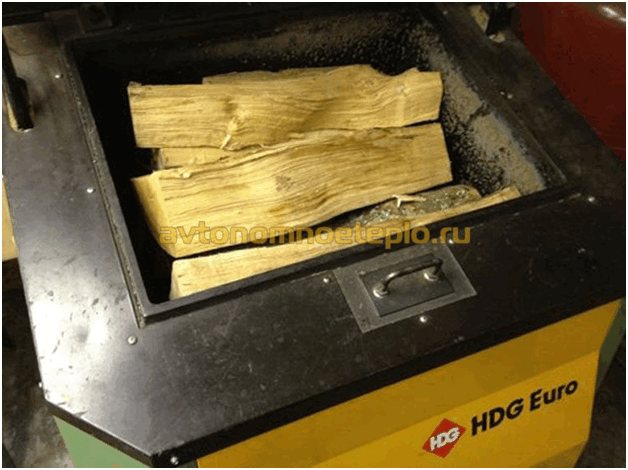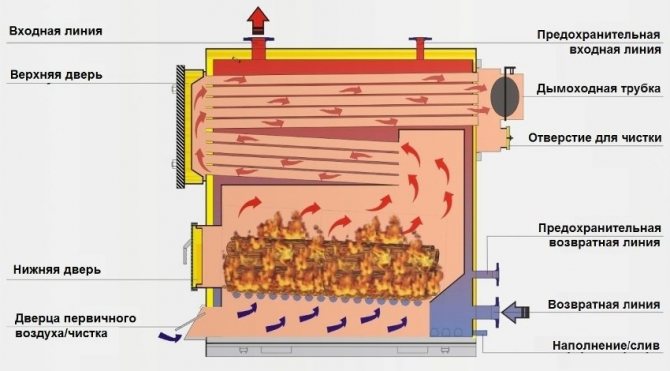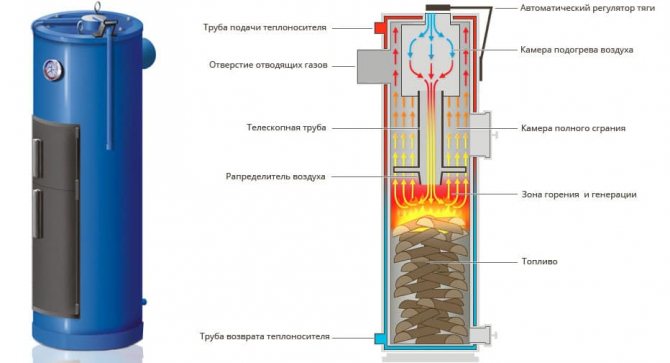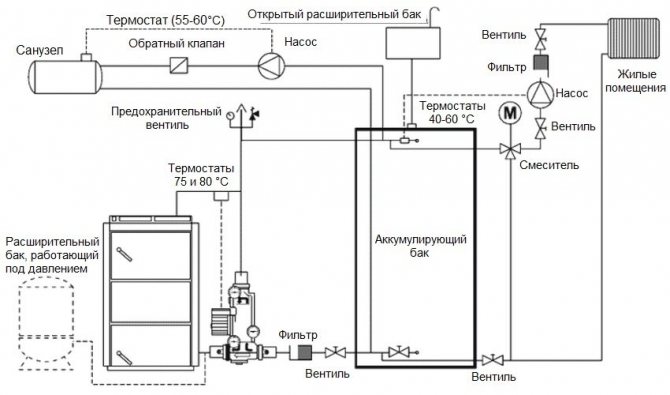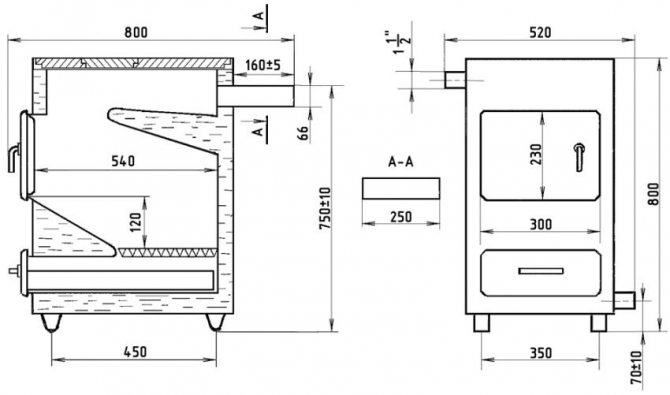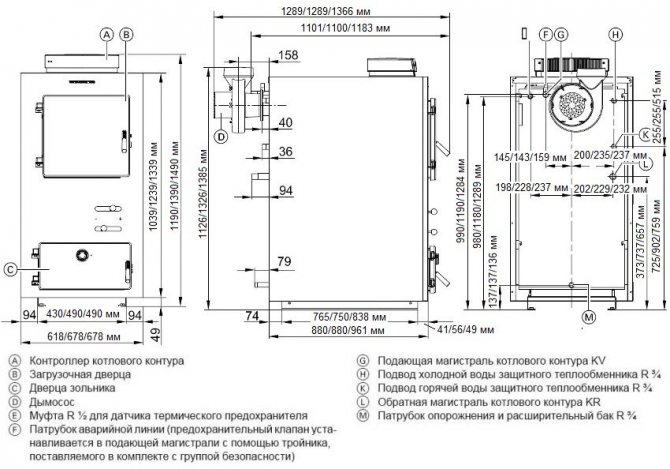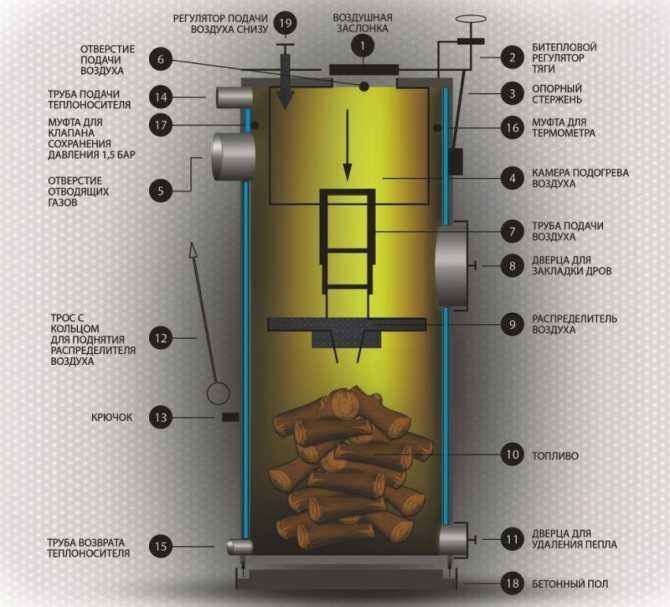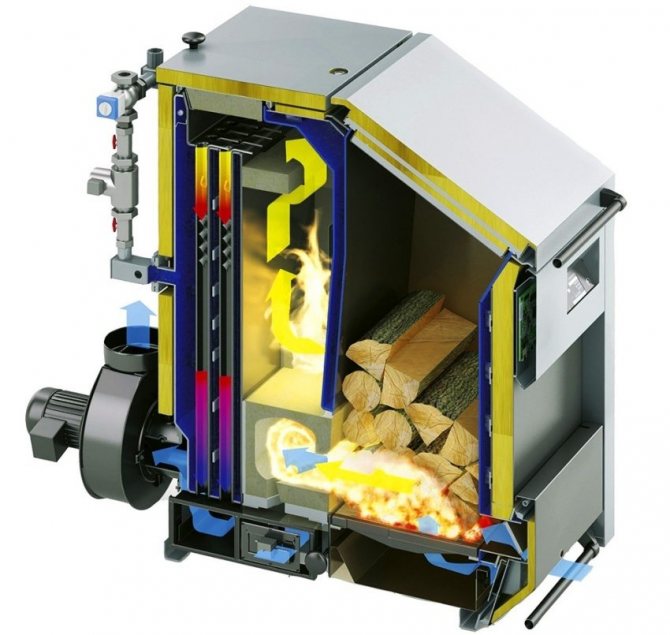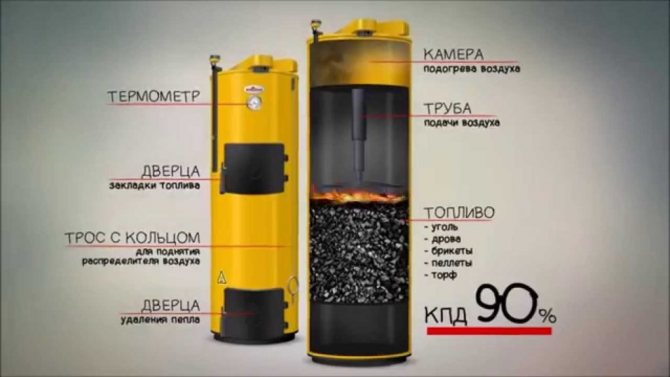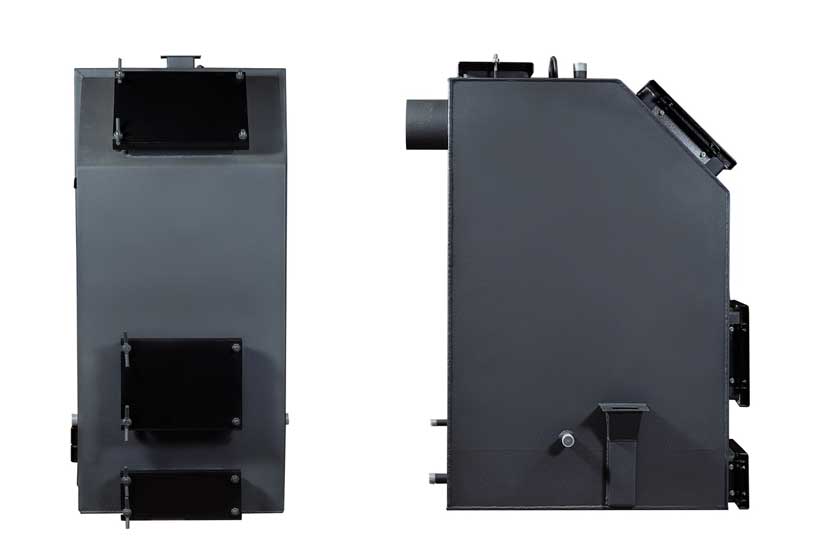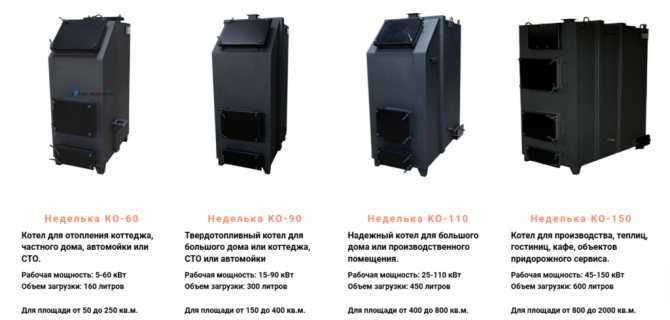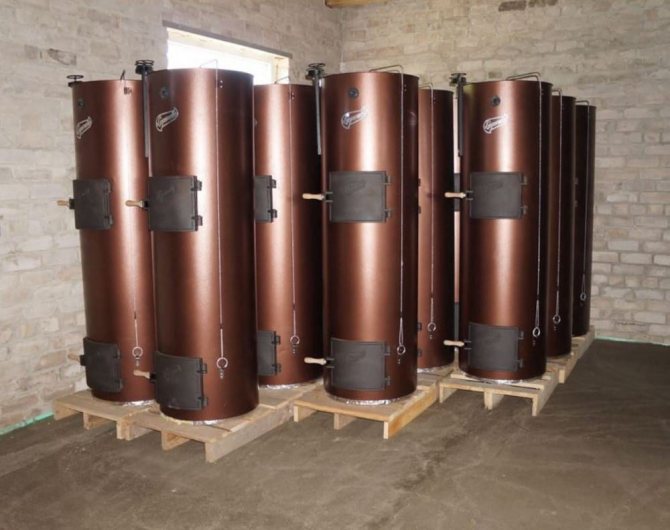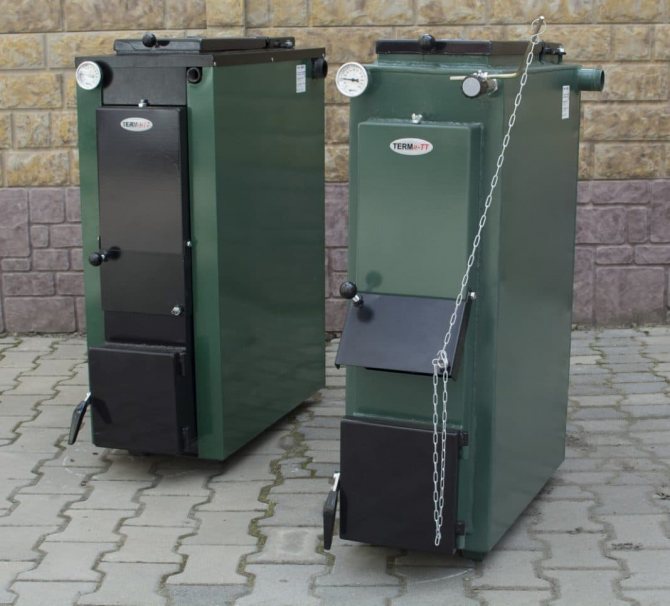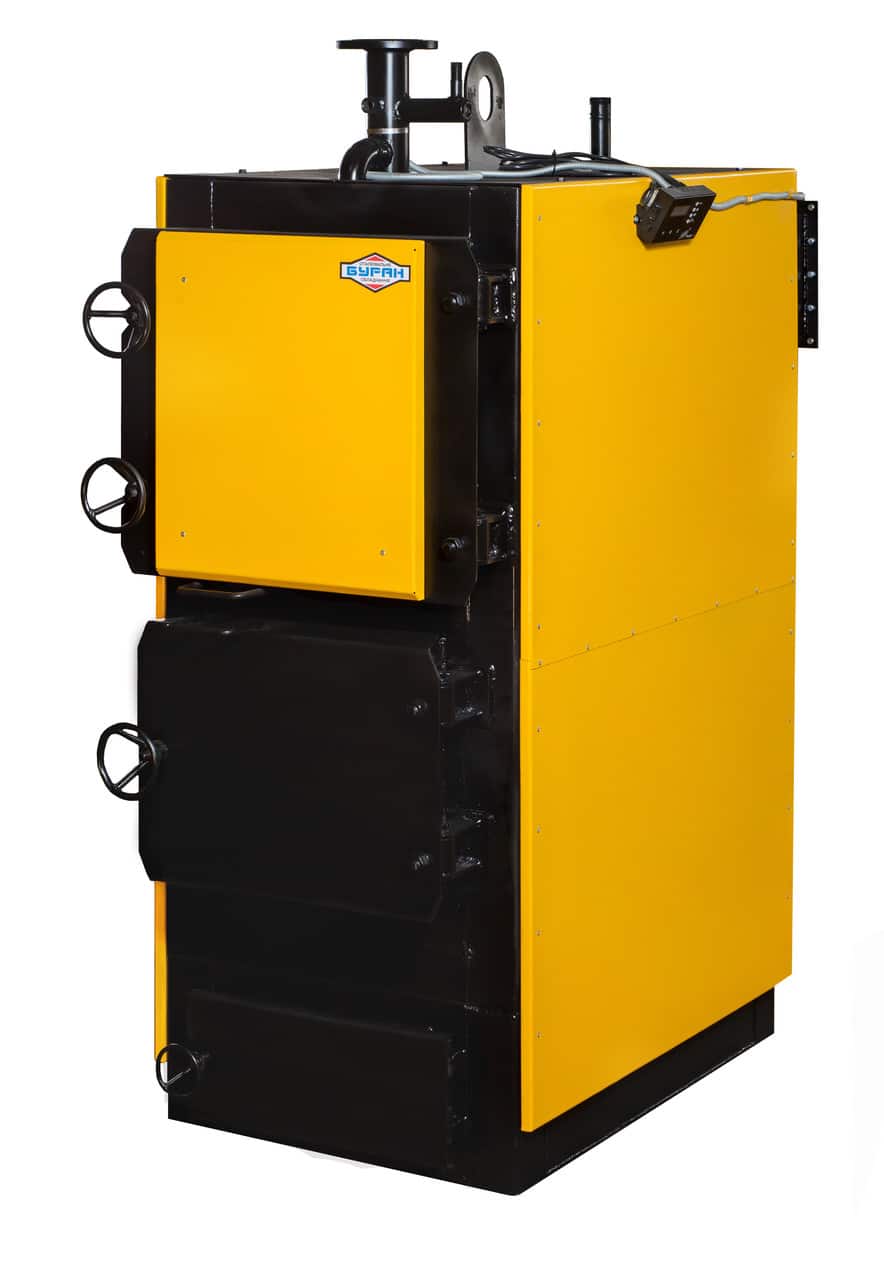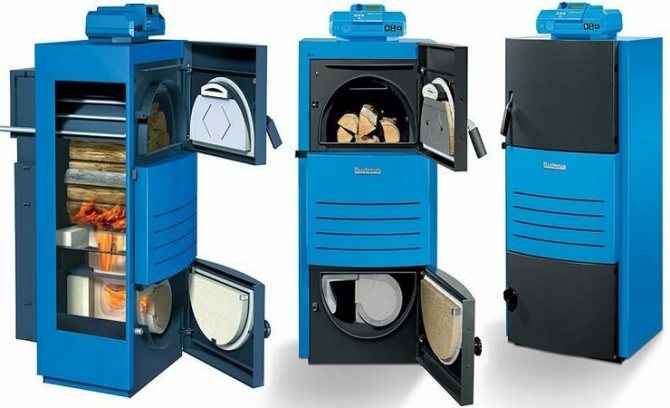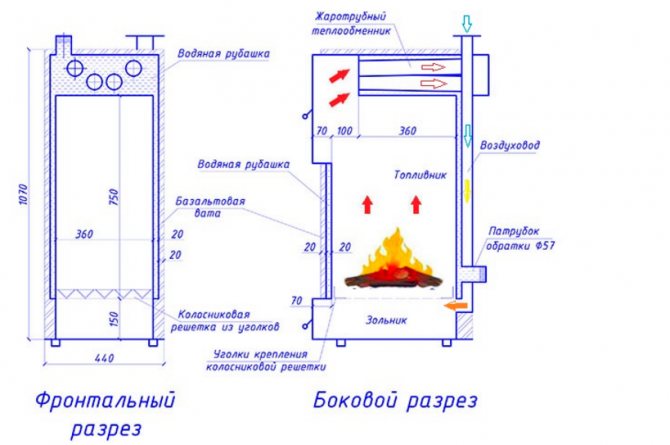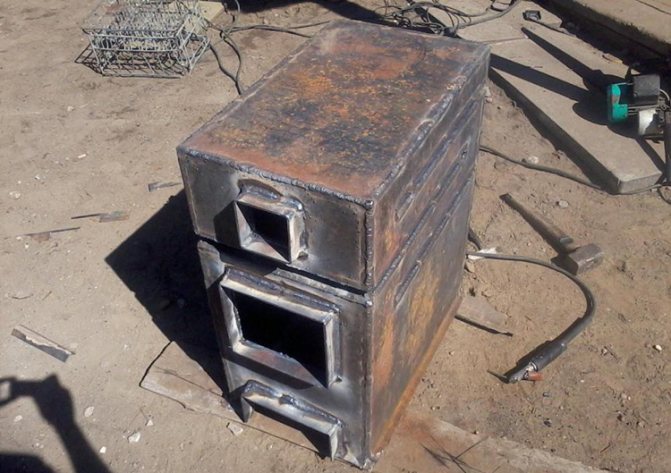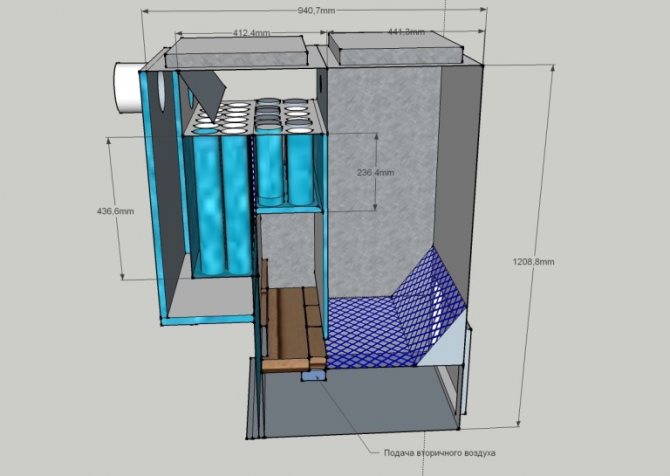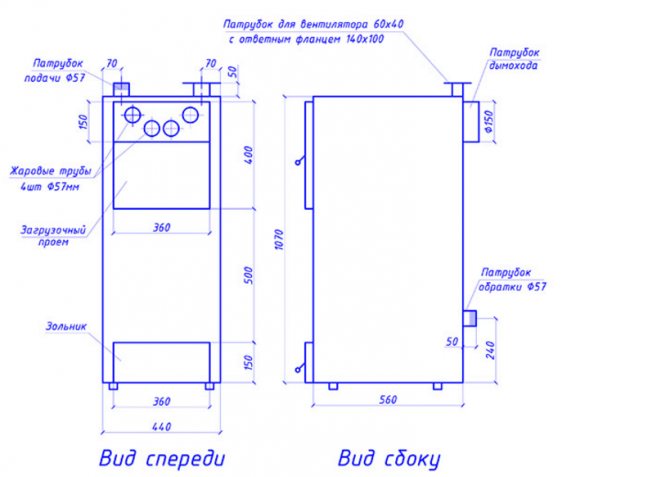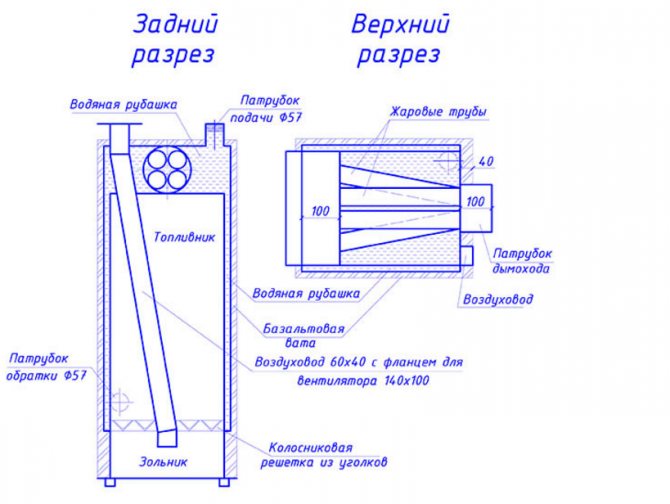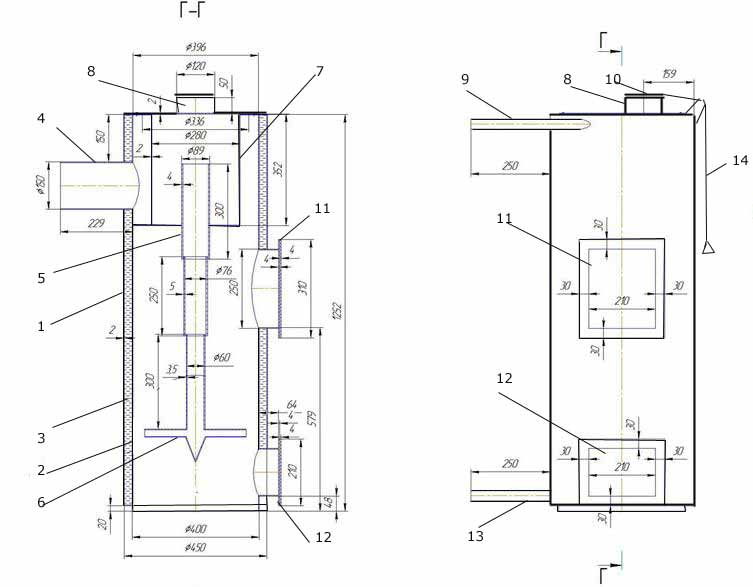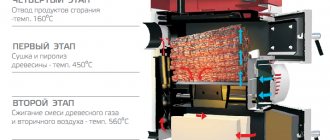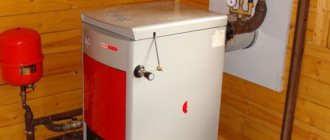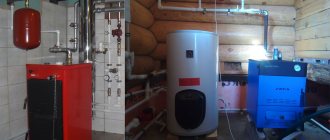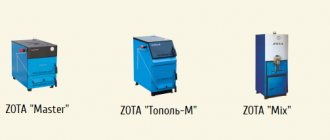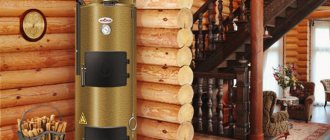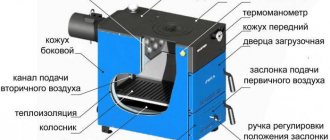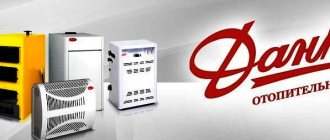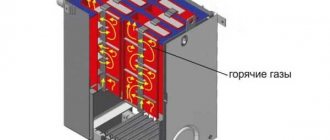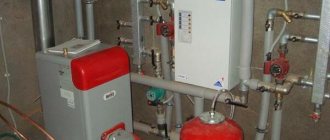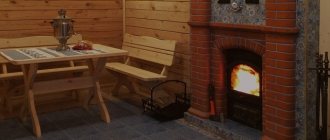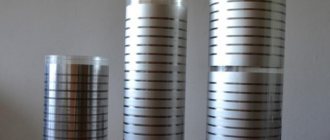Design features and principle of work
The inner part is used as a firebox. It is designed so that combustion occurs from top to bottom. This is facilitated by a special air supply directly to the combustion zone. The process is more reminiscent of smoldering with the production of gases from carbonaceous fuels. To a large extent, these gases are flammable. Due to their afterburning in the upper part of the furnace, the maximum use of thermal energy occurs, which makes it possible to increase heat transfer and reduce fuel consumption.
The boiler chamber is divided into two parts by an air distributor. It has the shape of a pipe, to which a pad with blades is attached at one end, and the other end serves to supply oxygen.
Top-firing boilers are characterized by a cyclical operation, and until the first tab burns out, the addition of a second batch of fuel will not be necessary.
Solid fuel pyrolysis boiler
The difference between this design is that solid fuel does not burn in it, as in ordinary fuel, but if there is a lack of primary air supply, it is "distilled" into wood (pyrolysis) gas, which is burned in a special afterburner chamber when secondary air is supplied to it. Such a feed can be both natural and forced.
Schematic drawing of one of the options for the pyrolysis boiler
1 - draft regulator with a thermal sensor; 3 - firewood; 4 - lower door; 5 - lattice; 6 - air damper for primary air supply; 7 - ash pan; 8 - grate; 10 - cleaning; 11 - drain; 12 - housing thermal insulation; 13 - return flow (supply of coolant from the system); 14 - nozzle; 15 - secondary air supply; 16 - chimney damper; 17 - a pipe with heated water; 18 - damper; 21 - loading door; 22 - afterburner chamber.
Technical characteristics of solid fuel boilers
Top fired boilers are produced with different capacities from 8 to 95 kW. Some models can reach 1200 kW. The higher the indicator, the more efficient the operation of the unit and the larger the area can be heated. The boilers with the minimum output are designed for installation in small houses. Ukrainian "Burany" with 40 kW are intended for heating large houses or warehouses.
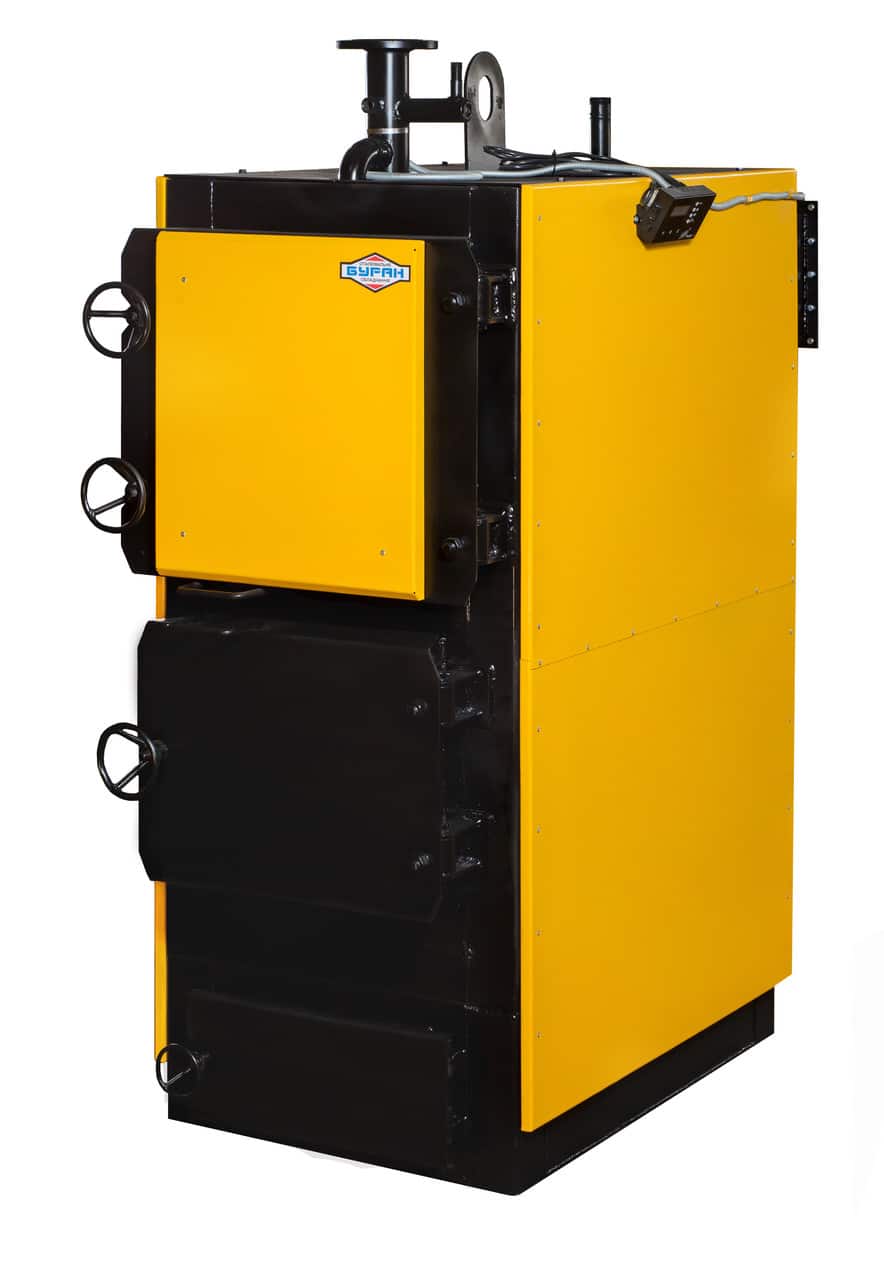
Solid fuel boiler BURAN-EXTRA 1200
Boiler materials are cast iron or steel. A cast iron heat exchanger is more durable, but due to its heavy weight, it can be difficult to install. Steel heat exchangers are made of steel of various qualities from low-grade to high-quality, resistant to high temperatures. In addition, steel boilers are often protected from fireclay bricks.
Most often, top-fired boilers run on wood, but there are models in which you can stack coal, peat briquettes, shavings and other fuels.
The efficiency of the boilers is 85-93%. According to the manufacturers, the operating time of the device after one load of firewood is from 8 to 31 hours, and on coals up to 5 days. An average inexpensive boiler produces heat within 5-8 hours.
Water heating temperature 70 0 C on wood and 85 0 C on coal. The recommended inlet temperature is from 60 0 C. The heating system can be either natural or forced circulation.
Boiler installation
For the location of the boiler, a warm non-residential premises with an area of more than 5 square meters is selected, in which you will have free access to the boiler from three sides. The room should be isolated from the residential part of the house so that smells from the boiler room do not penetrate the rooms.For the boiler to burn well, there must be natural ventilation in the boiler room. Ideally, the boiler should be installed on a foundation and its proximity to combustible materials should be excluded, but if this is not possible, then a fire retardant gasket must be installed under the boiler and in front of it.
Next, the boiler is installed in the heating system, which is already installed in the house. It is necessary to carefully seal all joints between the boiler and the heating system and fix the temperature sensor on the supply pipe to the system. The most convenient way to do this is with a thermal cover, which is already included in the boiler equipment kit. Install the controller and fan and check that the fan damper rises freely.
After installation, it is necessary to fill the system and the boiler with a coolant, put cardboard or firewood on the boiler grate and pour coal into the boiler. Next, check that all hatches are hermetically closed, set the temperature to at least 60 degrees and go outside to check if there is smoke coming out of the chimney. After half an hour, open the drain hole - at the first start, a lot of condensation forms, it must be drained.
Advantages and disadvantages of solid fuel boilers for upper combustion
Top fired boilers have been providing users with heat for over 15 years. During this time, they have fully confirmed their effectiveness, which is ensured by the following factors:
- when the fuel is loaded, the distributor rises up, and after ignition it rests on the wood and falls as it burns out;
- in the place where air enters, incomplete oxidation of hydrocarbons occurs. Gas with ash particles is transferred to the upper part of the combustion chamber. There oxygen joins it, as a result of which it is burned out and gives off the remaining heat;
- at the beginning of the gas combustion chamber, there is a draft regulator. It automatically detects the temperature of the water and regulates the rate of combustion of volatile compounds.
The boilers have the following advantages:
- long operating time and minimum number of downloads;
- energy independence due to work with natural circulation and natural draft;
- the versatility of some units in terms of fuel: coal, firewood, shavings, peat, etc.;
- a small amount of fuel is able to ensure high efficiency of work;
- automated continuous operation of the boiler for supplying hot water and heat;
- the absence of complex mechanisms makes the boiler operation simple even for beginners;
- high level of security;
- long service life of 10-15 years or more.
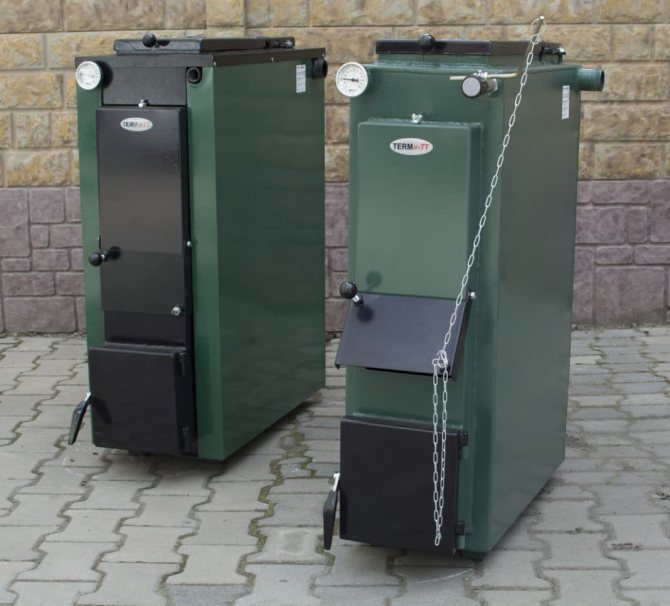

The upper combustion boiler has a high level of safety
Disadvantages of solid fuel boilers with top loading:
- high cost compared to other installations;
- sensitivity to changes in heat exchanger temperature. Condensation and oxidation of steel elements are possible;
- increased ash content can clog the combustion zone and reduce the level of heat transfer;
- it is necessary to regularly manually clean the chimney and ash pan;
- inconvenient laying of firewood due to design features;
- you cannot load large fuel, for example, not chopped firewood;
- the fuel must be completely dry, so you need to think over the conditions for its storage;
- incomplete loading makes firing up inconvenient; the firebox is deep enough;
- it is impossible to carry out additional loading if the process is already running;
- the support beam and disk, which serve as a partition between the combustion zones of solid fuel and gas, quickly fail.
As you can see, solid fuel boilers for upper combustion are not without drawbacks, therefore, before purchasing such a device, carefully weigh the pros and cons.
How DRGs work
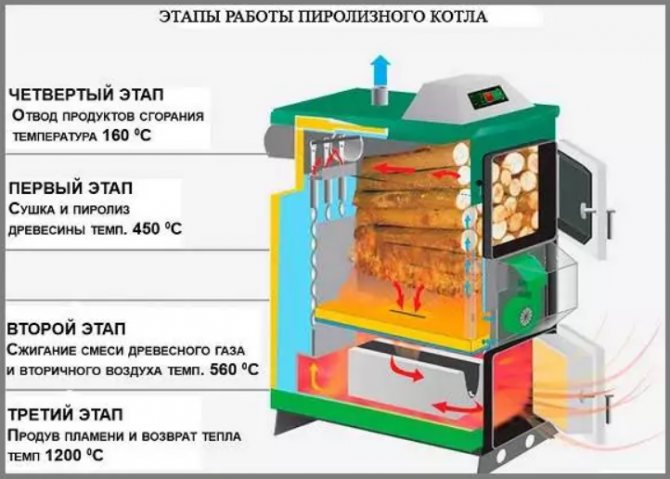

Most solid fuel stoves use the top-feed oxidizer (oxygen in the air) method to maintain combustion.In addition, immediately before entering the furnace, it is heated to a certain temperature, which contributes to better oxidation and minimization of combustion waste: ash, soot, etc.
Oxygen in them, unlike a fireplace, is supplied from the upper inlet, and then goes down to the lower part of the combustion chamber.
Due to this organization of air movement, at the initial stage, only the upper layer of solid fuel located in the chamber volume is effectively burned. After the reserves of this layer are exhausted, the oxygen supply to its lower part is switched on. As the next layer burns out, the air flow penetrates deeper and deeper into the furnace. Due to this, each subsequent portion of wood is disposed of only when its sequence arrives.
This approach allows you to save on the amount of fuel consumed and at the same time to clearly control the combustion process. The described features of the technology made it possible to classify boilers operating on its basis as long-burning heating equipment. Due to the specifics of their operation, these units are economical and guarantee a high level of environmental friendliness when disposing of all types of fuel.
Nuances of the upper combustion boiler control system
In long-burning top-burning boilers, the main control principle is the regulation of air flows entering the combustion chamber. The standard units are equipped with a mechanical device for this. The chain-driven damper is actuated by a thermostat.
The thermostat in the boiler is adjusted to a certain temperature regime. When the coolant heats up to the desired level, the damper is automatically set to a certain position, reducing the heating intensity. It is impossible to drastically reduce the temperature, because the coolant will continue to heat up by inertia, heating the room.
Devices with fans work a little differently. If you need to increase the power of heat transfer, then this can be done precisely at the expense of the fan. The appliance will blow air. Due to it, it is possible to reduce the inertia of the boiler. The control takes place automatically, and the sensors record the slightest changes in the temperature of the coolant.
Heating with a Nedelka boiler at a house in the Kemerovo region
The boiler was purchased for heating a cottage with an area of 200 square meters in the village of the Kemerovo region, where in winter the temperature steadily drops to -25C. Taking into account the area of the house and the budget, we settled on the KO-60 model - the most budgetary in the line of boilers from this manufacturer. Since it was decided to save money, the boiler was installed and started up independently - the kit included a detailed step-by-step guide, in which all the stages of work were clearly described.
In the first days of boiler operation, we spent a lot of time adjusting the temperature, as a result, we came to the conclusion that it is most comfortable to live in a house at 23-25C. In winter, at a temperature of -20-25C, the boiler uninterruptedly heats the house for 2-3 days, with warming this period increases to 5-6 days. When the fuel runs out, the boiler must be thoroughly cleaned and re-melted, which usually takes from an hour to an hour and a half.
By the way, for the period of a week's departure, the boiler was left working and the temperature was set to 18C. By the end of the week, there was fuel in the boiler, and the heating system of the house was not frozen. After cleaning and kindling, the house quickly warmed up to a comfortable temperature.
Review of the best top-firing boilers
Currently, the production of solid fuel boilers has expanded significantly and many models of foreign and domestic firms are presented to the choice of consumers. Let's take a look at the best ones.
Stropuva
The boilers of the Bulgarian company Stropuva are compact units with high efficiency. The devices are equipped with a blower fan. The cylindrical body has a shaft structure.The devices are characterized by excellent performance combined with excellent design. Universal boilers can be heated with wood, peat or pressed briquettes. The power of the models is 8-40 kW, the heated area is 30-400 sq.m. The permissible moisture content of the fuel can reach 45%, which is fully consistent with modern requirements.
Liepsnele
In Lithuania, long-burning boilers are manufactured on solid fuel of a universal type, i.e., operating on any type of fuel. The power of the units varies in the range of 10-40 kW, the heated area is up to 400 sq. M. The maximum operating time on one coal laying is up to 7 days, firewood - up to 2 days. The design of the boilers is a classic mine type with top combustion. Liepsnele boilers have a high efficiency, not less than 90%, regardless of the type of fuel and the choice of operating mode.
Week
The boilers are rectangular in shape, have an attractive design and compact dimensions. For more complete heat removal, channels are provided through which heated flue gases pass. Russian top-fired boilers capable of operating on one coal load for up to 7 days.
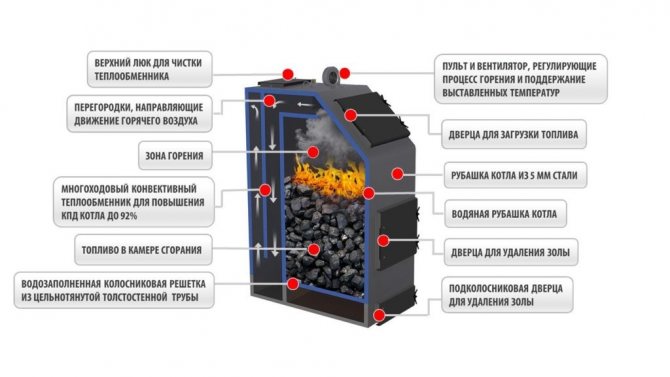

Boiler week
The company Nedelka offers four variants of boilers with different capacities, assuming heating of premises of different sizes: 50-250 sq.m., 150-400 sq.m., 400-800 sq.m., 800-2000 sq.m.
For water heating of a private house, many designs of heating devices have been developed. Mine boilers stand out for their efficiency and low maintenance. Their cost is quite high, so many craftsmen repeat factory models at home or make them according to their own design.
A mine boiler of long burning differs from others in the duration of combustion and in the features of the device. Often it is not required to add fuel, it has a large fuel chamber, and combustion is slow. Two types of mine boilers have been developed: with conventional combustion and pyrolysis. Each has a similar device of two chambers: one burns fuel, the other has a heat exchanger.
A mine boiler with conventional combustion is simpler in design. Half of the entire volume is occupied by a firebox with a height of almost the entire unit, but of small width and depth. On the side or on top there is a hatch for loading fuel. When viewed from above, the combustion chamber resembles a mine, hence the name. An ash pan is located under the combustion chamber, separated from it by a grate. Through the ash-pan door, access opens not only to it, but also to the firebox. The air intake is regulated by a gate located under the door.
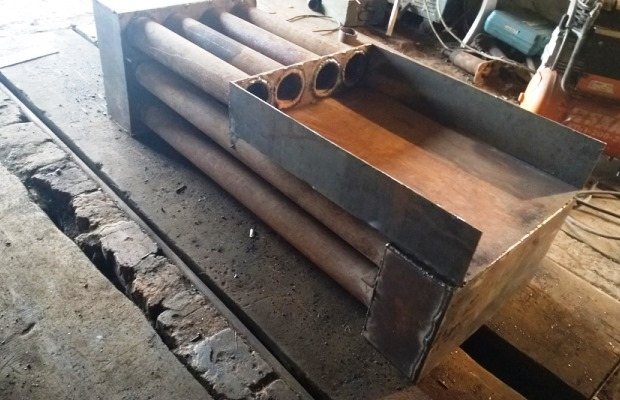

The mine boiler does not require special control due to its burning duration
The second important part is a chamber with a heat exchanger filled with water or, if the boiler is not used for hot water heating, a fire tube. Gases enter it from the firebox through the hole and exit through the chimney, simultaneously heating the heat exchanger. From it, water enters the system through pipes or hot air heats the room.
A shaft-type pyrolysis boiler has a similar design, but is manufactured with some additional elements:
- 1. Chambers in which carbon monoxide burns and burns out. Located at the bottom of the heat exchange space, the walls are lined with fireclay bricks.
- 2. Several pipes with many small holes. Through them, air is supplied for the combustion chambers and afterburning.
- 3. At the top of the wall there are valves for separating the two chambers.
The principle of operation of the pyrolysis boiler is somewhat different. During the firebox, the flow of air is limited, slow combustion causes the formation of a large amount of gases that enter the additional chambers and burn out. Boilers burn any solid fuel: coal, wood, pellets. One load of coal is enough for five days, firewood - no more than thirty hours.Due to complete combustion, such boilers have a high efficiency - up to 90%.
The proposed design has a power of 22 kW, an efficiency of 75%. It works on wood for 10 hours without additional loading, on coal - for a day. The firebox has a volume of 83 liters up to the lower edge of the loading opening. The boiler is equipped with Polish-made automatics: a control unit with a KG Elektronik SP-05 temperature sensor and a DP-02 fan. General view is shown in the drawing.
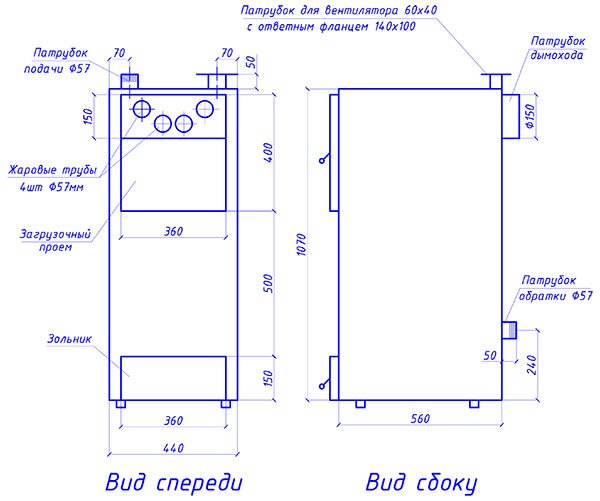

The device works as follows:
- 1. Firewood is loaded into the firebox and set on fire. The doors are hermetically closed.
- 2. The required heating temperature is set on the control unit, not less than 50 °. The unit button is pressed and the fan starts to blow air.
- 3. When the set temperature is reached, the air supply by the fan stops. Firewood smolders slowly, they give very little heat.
- 4. After a while, the temperature drops. The fan switches on again and combustion continues.
The electronic unit regulates the combustion process, which takes place at maximum efficiency. There is practically no smoldering, intensive combustion and standby modes are used.
The following figure shows an inside view.
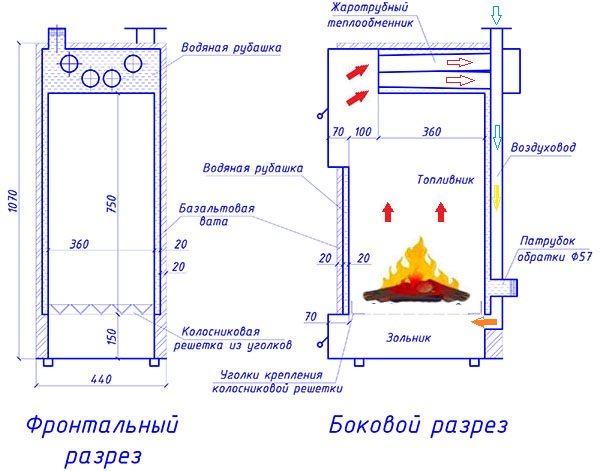

Solid fuel is burned according to the classical scheme: heat is directly transferred to the walls of the water jacket and the roof of the tank. It has a built-in heat exchanger that takes heat from gases. Heated air is fed into the firebox through the air duct from below. The fuel loaded in large quantities ensures a long operating time of the boiler. While waiting, when the fan turns off, the air is completely blocked off by a gravitational damper, triggered by automatic equipment, the natural draft is blocked.
The drawing shows the rear with a flame tube heat exchanger.
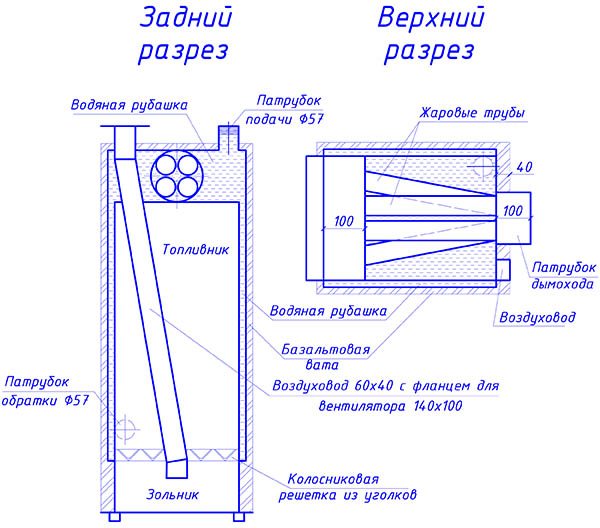

When assembling with our own hands, we use the drawings, we adhere to the specified dimensions. The sequence is as follows:
- 1. Cut out the body from 4 mm metal: bottom, side walls, lid, doorways. Everything sticks to the bottom, which is released to the sides, as in the drawing. Inside, we fix the corners by welding, which will serve as a shelf for the grate.
- 2. Carefully weld the joints and proceed to a 3 mm metal water jacket. It retreats from the walls of the body 20 mm and, to install it, we weld steel strips onto the body. We weld the skin to them.
- 3. Installing the flame tubes on top of the boiler. We cut holes in the back and front walls, insert several pipes, weld at the ends.
- 4. Cut out the doors, weld two strips from the inside, put asbestos between them for sealing. We cut the grates of 360 × 460 mm from the corners and weld them to the shelves with an outer corner.
- 5. In the walls of the tank we cut the fittings on the supply and return pipelines, the branch pipe of the smoke channel. We weld an air duct from a 40 × 60 mm profile pipe. A fan will be attached to it through the flange. The air inlet is through the back wall.
- 6. We weld on the door hinges and tabs for attaching the decorative frame. We wrap the boiler tank with basalt insulation, fasten it with a cord. We fasten the frame with self-tapping screws to the tabs, install the doors.
Heating boiler maintenance instructions
1.1 GENERAL INFORMATION
| Appointment | For heating and hot water supply | ||||
| Type of fuel | Solid fuel (coal, firewood) | ||||
| Maximum water pressure, kg / cm2 | 0,5 | ||||
| Maximum water temperature, ° С | 95 | ||||
| Heating capacity, max, kW | 30 | 40 | 60 | 100 | 150 |
| Heated area, m2 | 300 | 400 | 600 | 1000 | 1500 |
| Heating surface of a hot water boiler, m2 | 3 | 4 | 6 | 10 | 15 |
| Width, mm | 560 | 660 | 750 | 1200 | 1300 |
| Depth mm | 1200 | 1300 | 1300 | 1600 | 1800 |
| Height, mm | 1100 | 1100 | 1200 | 1600 | 1600 |
| Metal thickness, mm | 5 | ||||
| One-time download Fuel, l | 120 | 170 | 240 | 440 | 720 |
Boilers of this type are equipped with an inflatable fan and a mechanical thermostat (microprocessor controller) and are representatives of a new design of boilers with horizontal-vertical convection ducts, which allow controlling the boiler output. The design of the boiler allows the use of any type of fuel: coal, coal, wood.Additionally, using a distributed air supply system to the combustion zone allows you to effectively control the fuel combustion process in the chamber, and also allows you to effectively control the fuel combustion process as efficiently as possible with different boiler power.
The boiler furnace is a charging chamber equipped with steel water-filled grates. There is an ash pan under the heat exchanger.
The location of the filling, combustion and ash-pan doors allows quick access to the firebox for cleaning or firing up. Wide, angled loading doors facilitate fuel loading. Additionally, there are cleaning doors that allow cleaning the boiler flue channels. The air necessary for the correct combustion process is supplied by a fan thanks to a system of pressurized bushings located directly in the area of the loaded fuel. The microprocessor-based controller constantly measures the temperature of the water in the boiler and accordingly sets the blowing force of the fan, regulating the amount of air required for the combustion process.
The mechanical thermostat (microprocessor) ensures the constant operation of the boiler at the specified temperature of 85 ° C. The maximum water temperature in the boiler is 90 ° C. When this temperature is exceeded, the regulator turns off the air boost.
Hot gases pass through a steel heat exchanger where, after giving off heat, they are cooled. Cooled gases leave the boiler through a chimney connected to the flue pipe
The boiler water temperature can be monitored using a thermometer installed on the boiler.
It is strictly forbidden to use the boiler without an expansion tank.
This boilers are designed to work exclusively with open-type expansion vessels. The open-type expansion tank must have a volume of min. 10% of the total volume of the heating system.
The minimum installation height of the expansion vessel must be higher than the maximum height in the heating system.
The main fuel for this type of central heating boilers is coal for energy purposes of the nut assortment.
The central heating boiler is delivered assembled, namely: together with cleaning, filling, furnace and ash-pan doors.
Table 1. Standard boiler equipment
| Standard complete set | units rev. | qty |
| Maintenance instructions | PC. | 1 |
| Thermo regulator | PC. | 1 |
| Blower fan | PC. | 1 |
| Analog thermometer | PC. | 1 |
| Emergency valve | PC. | 1 |
During operation at a water temperature (supplying the central heating system) below 60 ° C, steam contained in the flue gases condenses on the boiler walls. During the initial period of boiler operation, condensate may leak onto the floor in the boiler room. Prolonged use at low temperatures can cause corrosion and shorten the life of the boiler. Therefore, it is not recommended to use the boiler at a low temperature of water supplying the central heating system lower than 60 ° C
Operation of the boiler at a temperature of water supplying the central heating system below 60 0C leads to an increase in the release of resinous substances from the combusted fuel, and this leads to overgrowth of the heat exchanger and chimney with resin deposits, which can lead to a loss of boiler performance.
Heating boilers of this type are designed to heat water in the central heating system to an outlet temperature not exceeding 85 ° C and with an operating pressure not exceeding 0.15 MPa. Used with a circulation pump in central heating and hot water systems.
Boiler connection diagram
1-boiler;
2-circulation pump;
3-battery;
4-expansion vessel of open type
5- filter in front of the circulation pump
6- tthermostatic regulator
3. REQUIREMENT FOR CHIMNEY
To avoid the ingress of condensate from the chimney into the boiler.
The chimney must be connected to the boiler using an elbow. Direct connection of the chimney is not allowed.
The chimney from the street side must be insulated with a non-combustible material.
4. REQUIREMENT FOR BOILER ROOM
The boiler room must be separated from the living quarters to avoid the ingress of carbon monoxide into the living quarters.
Before starting up the boiler, check:
system passability,
correct filling of the installation with water,
the condition of the water in the expansion tank.
Before starting the ignition, the furnace doors and ash-pan doors should be fully opened, while the filling doors should be completely closed. The ignition should be carried out slowly, using crumpled pieces of paper and wood, to which, after the appearance of the fire, a layer of charcoal should be added. When coal starts to burn, close the furnace and ash pan doors, then open the filling doors and fill the combustion chamber with fuel. When the flue gases enter the chimney, open the charging doors, turn on the boost, set the desired temperature on the regulator.
If the fire goes out during firing up, clean the furnace, ventilate the boiler channels and reignite.
Charcoal with a moisture content of no more than 20% should be poured into a combustion chamber cleaned of ash (too high humidity will lead to the appearance of water droplets on the walls of the boiler, which can cause increased corrosion). Coal should be poured up to a level a few centimeters below the top pressurization holes on the side walls of the combustion chamber and should not cover these holes. If coal accidentally falls through the grate into the ash box, it must be returned to the combustion chamber. The poured layer of wood should be leveled (without tamping), put paper, wood and set on fire. When the flue gases enter the chimney, open the charging doors, turn on the boost and set the desired temperature on the regulator. After ignition, the fire should develop over the entire area with a yellow-blue flame. In the event of grooves or uneven combustion, it is recommended to fill in the groove and scatter the burning layer over the entire surface of the furnace.
When using regulators with the possibility of programming the hour limits, too large differences in the set temperatures should be avoided, which can lead to the so-called "shooting" in the boiler. In addition, the boiler temperature should not be set too low (below 55 ° C), as this negatively affects the combustion process and increases the release of harmful substances into the atmosphere. If the boiler is operated at low temperatures, water vapor droplets (“sweating”) may appear on the walls of the boiler. Prolonged "sweating" can lead to corrosion and shorten the life of the boiler. For this reason, a sufficiently high boiler operating temperature should be set, and the temperature in the house should be regulated using thermostatic regulators on the battery. The time of fuel combustion depends on its quality and quantity, therefore, the user must find out the convenient amount of fuel and the burning time by selection.
THE COMBINATION CHAMBER AND THE ASHMAN SHOULD BE ALWAYS CLOSED, EXCEPT THE TIME OF FIRING, LOADING THE FUEL OR CLEANING THE ASHMERGE FROM ASH. IN THE CASE OF ELECTRICITY, THE BOILERS CAN OPERATE WITHOUT A REGULATOR, ON NATURAL DRAFT, UNDER THE CONDITION OF A GRAVITATIONAL HEAT RECEPTION. FOR THIS SHOULD OPEN THE DOORS OF THE ASHIRE AND PUT THE BOILER FROM THE BOTTOM, GRADUALLY ADDING FUEL. IN THE CASE OF A SHORT-TERM LOSS OF ELECTRIC POWER, i.e. FOR 3-4 HOURS, THE SMOKING CHARCOAL REMAINING IN THE BOILER ALLOWS THE BOILER WITH A REGULATOR TO RE-START.
WHEN BROKENING A COLD BOILER, WATER STEAM CONDENSATE MAY APPEAR ON THE BOILER WALLS - “DRYING” CREATING AN ILLUSION THAT THE BOILER LEAKS. THIS IS A COMPLETELY NATURAL PHENOMENON WHICH WILL DISAPPEAR AFTER THE BOILER HEATES ABOVE 60 ° C.IN THE CASE OF A NEW BOILER, DEPENDING ON THE ATMOSPHERIC CONDITIONS AND THE WATER TEMPERATURE IN THE BOILER, THIS PHENOMENON MAY LAST FOR SEVERAL DAYS. USING THE BOILER AT A TEMPERATURE ABOVE 60 ° C PREVENTS THE APPEARANCE OF MOISTURE AND CORROSION ON THE BOILER.
During normal use of the boiler, the boiler maintenance process consists in timely filling the combustion chamber and cleaning the ash pan. One portion of fuel is enough for more than 24 hours of boiler operation with the specified power. At lower power, the heating time can be extended by several hours.
It is allowed to add fuel. When adding fuel to the combustion chamber, turn off the fan, then slowly open the filling doors, add fuel, close the doors and turn on the fan again.
Working principle of wood heating boiler, long burning
The device and principle of operation of a wood-burning boiler for long-term operation from one load is aimed at recreating such conditions in the limited space of the combustion chamber. Firewood does not burn in the full sense of the word, but smolders. The operating time increases, and the lack of heat is compensated for by the afterburning of the released gases.
The design of long-burning boilers includes the following units:
- Combustion chamber - the device has two combustion chambers at once. The first furnace (with vertical or horizontal loading) is designed for wood burning. The second chamber is used for afterburning the produced carbon dioxide. To ensure complete combustion of gas, the firebox is made of fireclay bricks, which prevents heat loss and helps maintain a temperature of about 800 ° C.
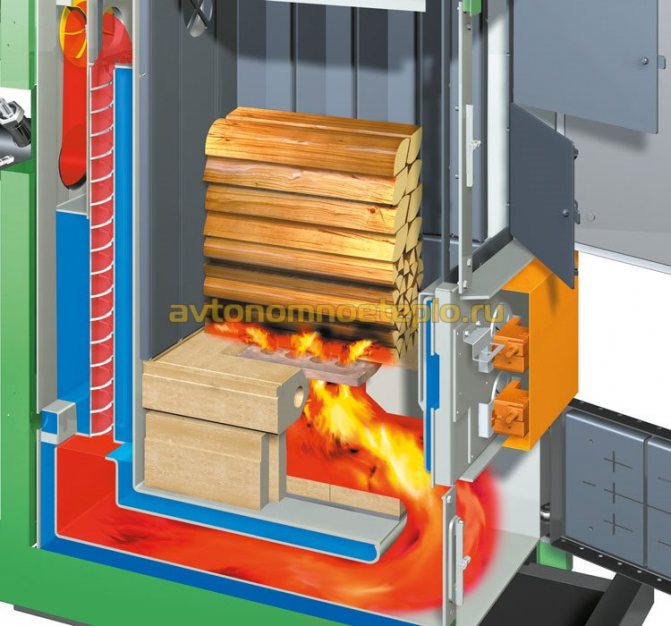

Diy heat exchanger for a solid fuel boiler
First, the firebox is assembled from two side, one rear and one upper walls. The seams between the walls are made with full penetration (they must be sealed). A 20x3 mm steel strip is horizontally welded to the firebox from 3 sides from below, which will serve as the bottom of the water jacket.
Further, to the side and rear walls of the furnace, it is necessary to weld short pipe sections of a small diameter in random order - the so-called clips, which will ensure the rigidity of the heat exchanger structure.
Now the outer walls of the heat exchanger with pre-drilled holes for the clips can be welded to the bottom strip. The length of the clips should be such that they protrude slightly beyond the outer walls, to which they must be welded with an airtight seam.
Coaxial holes are cut in the front and rear walls of the heat exchanger above the firebox, into which the flame tubes are welded.
It remains to weld pipes to the heat exchanger to connect to the heating system circuit.
How to choose a slow burning wood burning boiler
Long-burning wood-fired heating boilers are offered by several domestic and foreign manufacturers. The design of the equipment, as well as the thermotechnical characteristics, differ significantly. When choosing a heat generator, pay attention to the following parameters:
- Performance.
- Design features.
- Manufacturer country.
According to the three parameters listed above, a suitable boiler model is selected for domestic needs.
Power calculation
A properly selected wood-burning heating boiler for long burning, easily copes with heating living space up to 400 - 500 m². When choosing, the performance of the heat generator is taken into account. Power calculation is performed as follows:
- Calculate the total area of the house.
- Calculate the required power of the boiler using the formula 1 kW = 10 m².
- If a DHW circuit is present in the structure, 15-20% of the reserve is added to the result obtained.
The above calculations are suitable for buildings with an average degree of thermal insulation located in the middle latitude of Russia and having a ceiling height of no more than 2.7 m. For rooms with a complex configuration, a large number of window and door openings, calculations are carried out using online calculators.
The process of making a solid fuel boiler from a brick with your own hands
What materials and tools are needed for construction?
To build a solid fuel boiler with your own hands, you need to have the slightest knowledge in welding, the skills of a bricklayer and be able to use a gas cutter. It is advisable to understand the marking and cutting of the working material, as well as have an idea of \ u200b \ u200bworking with power tools. With such a baggage of knowledge, it will be possible to quickly build a high-quality solid fuel boiler at the lowest price. This will require the following materials:
- clay, brick;
- grate;
- pipes;
- gravel;
- water;
- sheet metal;
- doors;
- water pump and water heating device.
It is necessary to prepare the following tools:
- welding machine;
- Bulgarian;
- gas cutter;
- a marker that is clearly visible on metal;
- putty spatula;
- level;
- pliers;
- roulette;
- electric drill.
To protect yourself, it is important to prepare personal protective equipment (goggles and a mask) and only after that start making a brick boiler.
Stages of work
Vertical solid fuel heating devices are popular, which can be designed independently as follows:
- Prepare the heat exchanger and remove the dimensions from it for the manufacture of the combustion chamber.
- Build a foundation of brickwork or rubble stone.
- Lay the boiler base with a waterproofed roofing felt gasket.
- Lay the bottom of the chamber and the blower with the door with oven bricks and separate them with a cast iron grate.
- Install the TO and lay out the walls of the brick, leaving a gap of 1.5-2 cm.
- A door is attached to the front, covering the stored fuel, and an opening for the chimney is left at the back.
- A cast-iron cooking stove or a thick metal sheet lined with a layer of brick is laid on top of the chamber walls, if it is not planned to use the boiler for cooking.
- The smoke outlet is located on the side or on top of the combustion chamber, making it from a metal pipe or building material.
- When the masonry is well dry, the heat exchanger pipes are attached to the pipeline using couplings or by welding.
- Finally, a test furnace is made and the operation of the heating device is checked.
Back to the table of contents
Features of operation of wood boilers with long burning
The burning time of one bookmark of firewood is from 8 to 24 hours. The battery life depends on several factors:
- Boiler type.
- Fuel quality.
- Correct operation.
Learning how to properly heat the boiler is much easier than it might seem at first glance. During firing up and further operation, they adhere to the requirements specified by the manufacturer in the technical documentation. After a few fireboxes, the process becomes familiar.
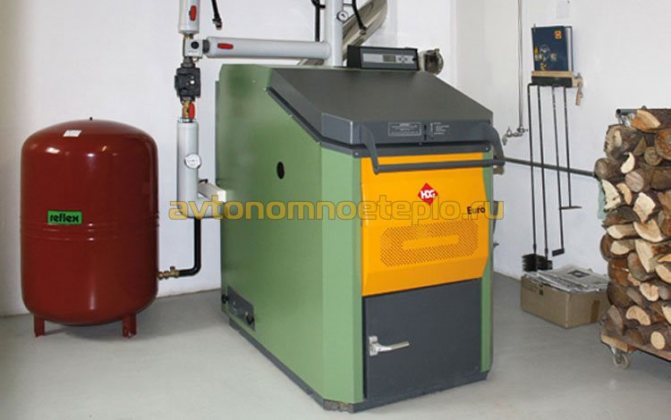

How to achieve long burning firewood
You can achieve long-term burning of firewood by carefully following the manufacturer's recommendations:
- Firewood is ignited with the damper fully open.
- The boiler is switched to the long burning mode only after reaching the temperature of 600 ° С.
- The moisture content of the wood should not exceed 20%. Heating with conifers is not recommended.
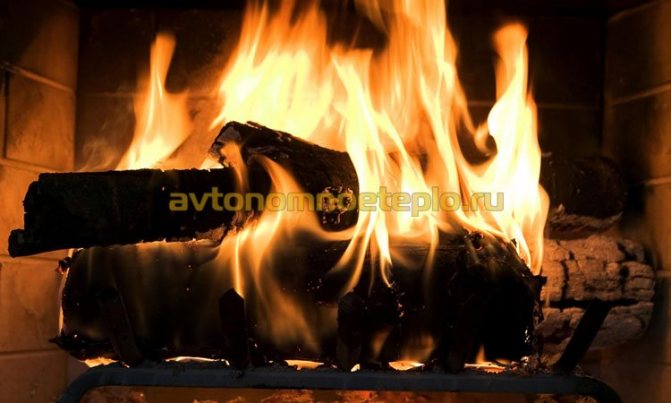

Violations of the operating rules lead to the formation of resin from the wood in the boiler. Most often, the following conditions are not met:
- The minimum temperature of the coolant at the outlet should not fall below 65 ° C.
- It is correct to heat the boiler with hardwood firewood: aspen, beech, acacia, oak, etc.
- The high moisture content of the wood leads to an abundant release of resin.
Correct operation of long-burning boilers prolongs the service life of equipment and increases heat transfer.
How to load firewood correctly
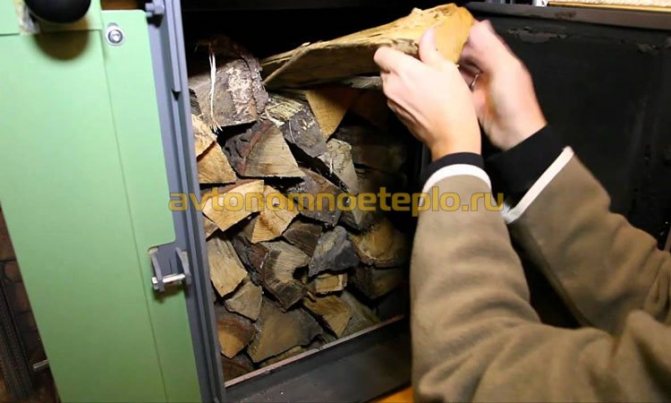

The ignition is carried out exclusively with dry splinters. It is prohibited to use gasoline or kerosene for kindling firewood. From time to time, it is recommended to use special chemical briquettes that remove tarry deposits on the walls.
How much firewood is needed for the winter season
The device of the boiler for long burning, allows saving on fuel, approximately 15-30%, depending on the selected model. The approximate consumption of firewood is calculated as follows:
- It is generally accepted that for heating every 100 m², 3 Gcal / month will be required.
- When a kilogram of firewood is burned, 3200 kcal are released.
- To obtain 1 Gcal, long-burning boilers burn 312 kg of firewood.
- To obtain 3 Gcal, you will need about a ton of wood.
During the heating season, to heat a 100 m² house, you need 7-8 tons of firewood.
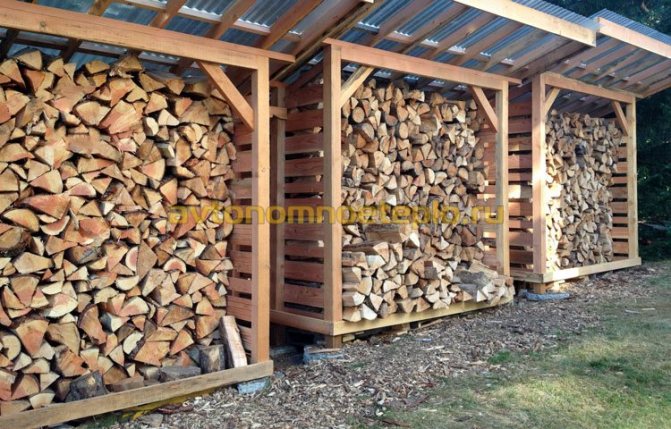

Rules and regulations for the installation of a long burning wood boiler
The installation of a long-burning boiler is carried out in compliance with the standards applicable to all boilers operating on wood. During the installation work, take into account the existing requirements of PPB and SNiP:
- Installation is carried out on a solid non-combustible base. Walls and floors are covered with non-combustible building materials.
- The chimney is carried out in compliance with the fire cuttings. At the junction to the wall made of combustible material, fire-resistant insulation is laid. The material is lined with steel sheet.
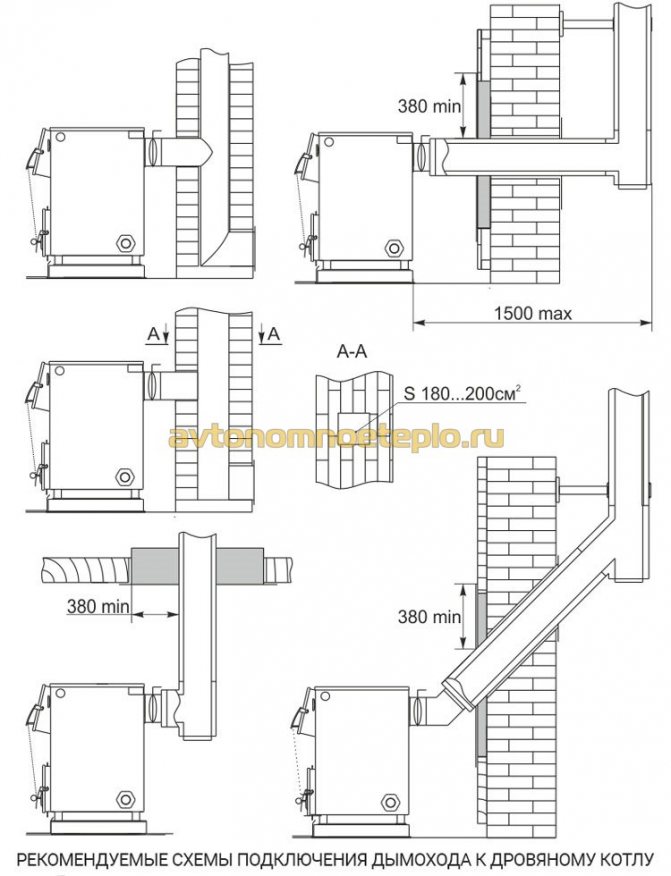

Water heating from a long-burning wood-fired boiler is connected to special outlets located on the boiler body. The instructions indicate in detail which branch pipe goes to the supply and return of the water circuit.
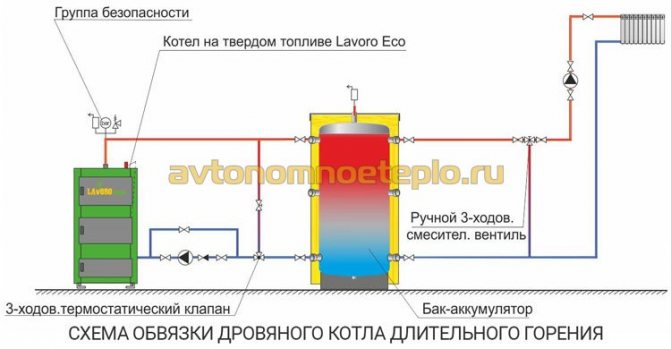

- A boiler with a capacity of more than 40 kW is installed in a separate room.
- Volatile boilers are connected to the power supply through a stabilizer and an uninterruptible power supply. Be sure to use machines. The connection is made directly from the control room.
In the room used for the boiler room, it is necessary to have supply and exhaust ventilation and natural light. If necessary, the boiler can be placed in a basement.
Boiler assembly
The unit must be assembled in the following sequence:
- First, the body is made by grabbing the side walls and the framing of the openings with short seams to its bottom. The bottom of the body itself serves as the lower frame of the ash pan opening.
- From the inside, corners are welded to the body, on which the grate firebox pan (grate) will be laid.
- Now you need to weld the grate itself. The corners of which it consists must be welded with the outer corner downward, so that the air entering from below is evenly distributed by the two inclined surfaces of each corner.
- Further, a firebox with a heat exchanger is welded to the corners on which the grate is laid.
- The firebox and ash pan doors are cut from sheet steel. From the inside, they are framed by a steel strip, laid in two rows, between which you need to lay an asbestos cord.
Long burning boiler Week KO-150
From which side the side hatch will be convenient for cleaning the heat exchanger:
Left Right
Boiler casing:
Non-insulated casing Insulated casing
| Add to Shopping Cart |
Minimum payment from per month
Purchase on credit Post Bank
2020 model. Legendary reliability! Operating power in continuous burning mode: 70-150 kW (controlled by automatic equipment) Peak power: 150 kW
Payload volume: 600 liters
Burning time for the area (combustion indicators are calculated from the calorific value of coal at least 7500 kcal / kg): 800 sq.m. = 4-7 days * 1200 sq.m. = 3-5 days * 1500 sq.m. = 1-3 days *
Solid fuel boiler "Nedelka" KO-150 are made of high-quality steel 5 mm brand 09G2S.
A 25 mm water jacket around the entire perimeter of the combustion chamber allows you to quickly transfer heat to the coolant without creating an unnecessary load on the metal, thereby achieving a long service life of the boiler.
The grates are made of a thick-walled seamless pipe (STAL20 alloy) designed for the entire service life of the Nedelka heating boiler.
The enlarged heat exchanger makes it possible to take away the residual heat in the flue gases, which makes the boiler as efficient as possible.
For ease of installation, Nedelka boilers are produced with a side hatch for cleaning the heat exchanger on the right or left.
Quality control of manufactured boilers is carried out at every stage: from careful selection of suppliers of materials and components to pre-delivery check of all elements.
Operating temperature from +35 to +85 degrees Celsius (flow temperature of the heating medium) Operating pressure: 1.5 bar Boiler weight: ~ 1200 kg
The boiler kit includes a Prond Proton 405.01 combustion control panel and two WPA X2 blowers. The overall dimensions of the boiler and the documentation can be seen below from this text.
xn - 80ahcab0aeedqi2czi.xn - p1ai
The final stage
You need to do the following work:
- The top of the inner part of the water jacket is secured by welding.
- A hole is drilled in it for the chimney and a 130 mm pipe is welded.
- A similar hole is created in the upper part of the unit body and the workpiece is secured.
- Holes are drilled at the top and bottom of the water jacket, after which pipes made of 25 mm tubes are welded.
- To check the tightness of the heat exchanger, it is filled with water and the pressure is raised.
- The bottom is attached to the structure.
- From all sides along the perimeter, a professional pipe with a size of 20x20 millimeters is welded.
- A steel sheet with a thickness of 1-2 millimeters is attached on top.
- They fix the doors - furnace and loading.
- The structure is completely sheathed with basalt wool, and then with galvanized sheet.
You can also build a mine boiler out of bricks. Its structural device differs in that firewood is loaded into it through a hatch into a high loading chamber, hence the name of the unit.
Boiler device
Kholmov's heating unit has a mine structure. Such boilers are divided into two types:
- dependent on electrical power;
- working without being connected to the electrical network.
All Kholmov boilers have one design, which consists of the following elements:
- metal case;
- two chambers - a fuel and a shaft with a heat exchanger;
- thermostat;
- grate bars;
- the branch pipe to which the chimney is connected;
- thermal expansion compensators;
- inputs and outputs for draining, supply and outputs and installation of a safety valve;
- doors;
- pull-out tray for collecting ash.
The unit doors are made of two metal sheets, between which a layer of heat-insulating material is laid. Their edges along the contour are pasted over with a heat-resistant asbestos sealant. This design allows the doors not to get too hot - the maximum temperature of their heating reaches 80 degrees.
The covers are secured with special locks, only the rear cover panel is fixed with removable screws. The ash door is cooled by continuous air currents, so it contains less than 50 percent thermal insulation.
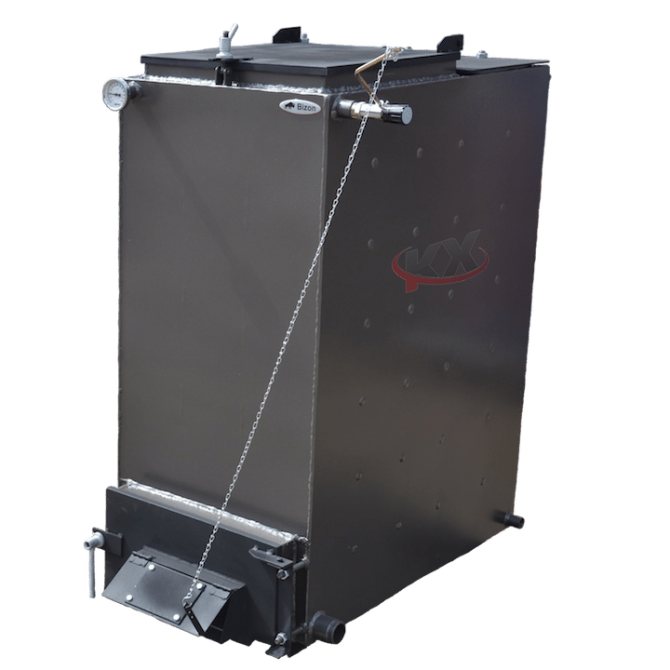

In the photo, Kholmov's boiler with an enlarged bunker
The bottom of the unit is a special plate covered with a material that reduces heat transfer. There is a camera on top, and two long, stable legs on the bottom.
Volatile designs of Kholmov's boilers are equipped with a fan and a device that controls the process. Units that operate independently of electricity have a thermostat on the front wall, with the help of which the heat transfer of heating equipment is automatically adjusted. The device is connected to the blower door with a special chain. The ash pan is located right under the chariot.When the door is open, the ash pan can be easily removed. At the bottom of the boiler there is a branch pipe for draining the working fluid. Entrance taps are located at the top, and return pipes are at the bottom.
Expansion compensators are located around the perimeter of the unit, and also in the form of rods and partitions are located in the body itself. They protect the case from increasing to critical volumes during warm-up. Thanks to this, the heat exchanger is also not deformed. The dividing walls are 24 centimeters apart.
How to heat a mine-type boiler
Like any other type of boiler equipment designed for heating residential buildings, a mine boiler has its own subtleties and nuances during operation. The first and most important thing for the normal operation of the unit is the quality of the fuel, and how the firewood is loaded into the fuel chamber. High thermal efficiency of a solid fuel mine boiler is achieved due to the correct stacking of firewood. Correctly placed fuel will not only ensure maximum operating efficiency, but also reduce the likelihood of smoke pollution in residential premises.
The quality of the fuel placement determines the duration of combustion and, accordingly, the duration of the operation of the heating unit.
On a note: the lack of the necessary skills leads to the fact that most of the consumers are not able to use the heating device correctly. Instead of gas generation, mine boilers operate as usual. Accordingly, the efficiency of the operation of such a unit is extremely low.
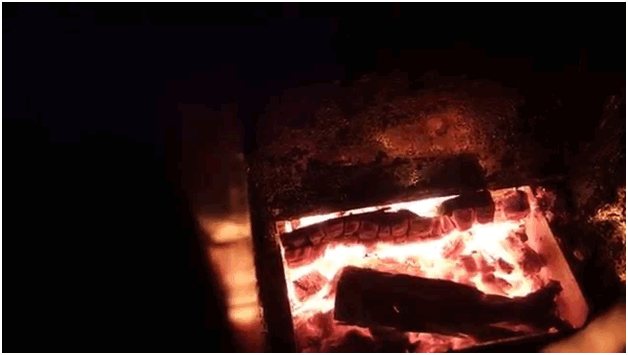

In order to properly use a mine-type heating device, it is enough to learn a simple algorithm of actions.
- Initial lighting of firewood in the traditional way.
- After 15-20 minutes, the boiler will be able to reach its rated power.
- After the boiler enters the operating mode, the remaining firewood is loaded into the fuel shaft and switches to the pyrolysis mode of operation.
Correctly selected and stacked firewood is a guarantee that the boiler will work for a long time, providing your home with warmth.
As for the fuel itself, a lot depends on the imagination and financial capabilities of the owner of the house. However, despite the fact that mine-type heaters are omnivorous, the boiler efficiency directly depends on what you heat the boiler with.
Fuel briquettes, woodworking waste, pellets go into the boiler furnace. Briquettes and pellets are considered an elite type of fuel, but their price is much higher than the cost of ordinary firewood. Moreover, if we take into account the unpretentiousness of the mine boiler equipment in terms of the fuel resource. Firewood is the main fuel for mine boilers. During operation, it is necessary to make at least half of the bookmark from firewood.
On a note: it is better to use hardwood firewood for the boiler. Pine and spruce logs have a high resin content, which can lead to the formation and accumulation of tar on the walls of the combustion chamber.
Method of stacking firewood in a mine boiler
Having dealt with the principle of operation of mine-type heaters, with the requirements for fuel, you need to pay attention to the methods of bookmarking.
The most frequent cases that owners of mine solid fuel boilers have to deal with are related to the hanging of firewood in the fuel chamber. The reason for this is the wrong bookmark. Taking into account the principle of operation of a mine boiler, where the main combustion occurs in the lower part of the device, the firewood should smoothly fall down under its own weight.
Failure to comply with the recommendations for laying firewood in this case is fraught with a sudden interruption of the main process - fuel combustion. Before starting the operation of mining units, the following recommendations should be adhered to:
- logs intended for laying should be smaller, several centimeters less than the values of the perimeter of the fuel shaft;
- firewood must always be laid across the shaft, and in no case along it;
- the driest logs are stacked at the very bottom, while damp firewood can be placed at the top.
Simple tips will help you get your boiler to work properly. One load of firewood, if all the bookmarking rules are followed, should be enough for 12 hours. The boiler will work independently all this time, without requiring your participation.
